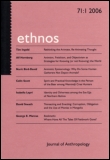articles on animism
The March 2006 issue of the journal Ethnos contains four excellent and important articles on aspects of animism.
Click here for the publisher's information about the journal.
Click here for the publisher's information about the specific issue, including click throughs to article information (abstracts).
The four articles are:
| Tim
Ingold, “Rethinking the Animate, Re-Animating Thought” |
Abstract Animism is often described as the imputation of life to inert objects. Such imputation is more typical of people in western societies who dream of finding life on other planets than of indigenous peoples to whom the label of animism has classically been applied. These peoples are united not in their beliefs but in a way of being that is alive and open to a world in continuous birth. In this animic ontology, beings do not propel themselves across a ready-made world but rather issue forth through a world-in-formation, along the lines of their relationships. To its inhabitants this weather-world, embracing both sky and earth, is a source of astonishment but not surprise. Re-animating the ‘western’ tradition of thought means recovering the sense of astonishment banished from official science. |
| Alf Hornborg, “Animism, Fetishism, and Objectivism as Strategies for Knowing (or not Knowing) the World” | Abstract Animistic or ‘relational’ ontologies encountered in non-Western (i.e. premodern) settings pose a challenge to Western (i.e. modern) knowledge production, as they violate fundamental assumptions of Cartesian science. Natural scientists who have tried seriously to incorporate subject-subject relations into their intellectual practice (e.g. Uexküll, Bateson) have inexorably been relegated to the margins. Surrounded by philosophers and sociologists of science (e.g. Latour) announcing the end of Cartesian objectivism, however, late modern or ‘post-modern’ anthropologists discussing animistic understandings of nature will be excused for taking them more seriously than their predecessors. It is incumbent on them to analytically sort out what epistemological options there are, and to ask why pre-modern, modern, and post-modern people will tend to deal with culture/nature or subject/object hybridity in such different ways. Animism, fetishism, and objectivism can be understood as alternative responses to universal semiotic anxieties about where or how to draw boundaries between persons and things. |
| Nurit Bird-David, “Animistic Epistemology: Why Do Some Hunter-Gatherers Not Depict Animals?” | Abstract This paper addresses the question of why certain hunter-gatherers (of the ‘immediate-return’ type in Woodburn’s terms) have little interest in visual art. Their lack of interest is striking in comparison with the elaborate traditions of painting and carving in Australia and the circumpolar North, which Ingold (2000) compares, showing that they correspond to totemic and animic ontologies respectively. The ‘immediate-return’ class of hunter-gatherers is examined in relation to Ingold’s typology, using the Nayaka of South India as a specific example. It is argued that their lack of interest in depictions corresponds to an ontology which is inseparable from their animistic epistemology (Bird-David 1999). This ontology differs from Ingold’s animic and totemic types and can be added to his scheme. |
| Colin Scott, “Spirit and Practical Knowledge in the Person of the Bear among Wemindji Cree Hunters” | Abstract The multi-vocality of the black bear as a category in Cree hunting entails a melding of practical-empirical rationality with ethical and ‘spiritual’ understandings. On one level of attention in the hunter’s world, the bear functions as a postulate in indigenous scientific ecology. It does so by assimilating the consequences of both efficiency and restraint in hunting, as hunters strive to maintain good relationships with others in the world (summarized and abstracted in the bear). At the same time, reflection on these issues via the bear as a spiritual ‘alter-’ endows hunters with profound senses of identity, value and personal meaning, so that action in the world is at once practical, social, ethical, and self-motivated. This outcome is a combination of cultural learning and life experience. As the weft of experience entwines the warp of culturally available categories, narrative is the weaver. |
I'm tempted to pick out a couple of favourite / important / provocative sentences from each article ... but I'm resisting reviewing each article. They're all good, especially in the sense that they all require and reward further thinking (and other responses).
Finally, for now, thanks to Rebecca Vickerstaff and Kate Arthur (Taylor and Francis) for sending me a copy of this issue. I'll be making much more use of it in my future writing and citing!
last updated 18 June 2006

click to return to my "more ethnography" page
